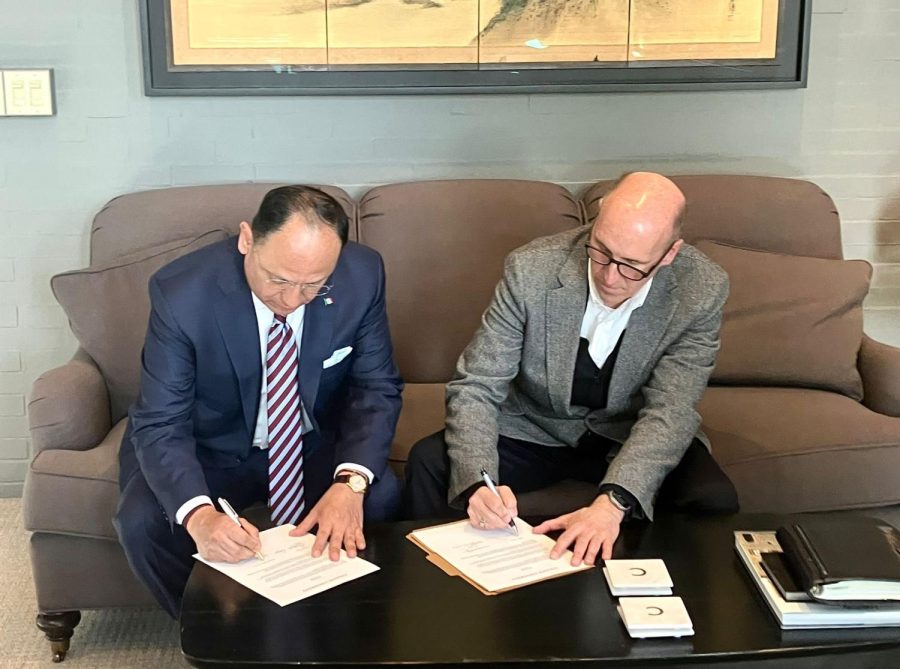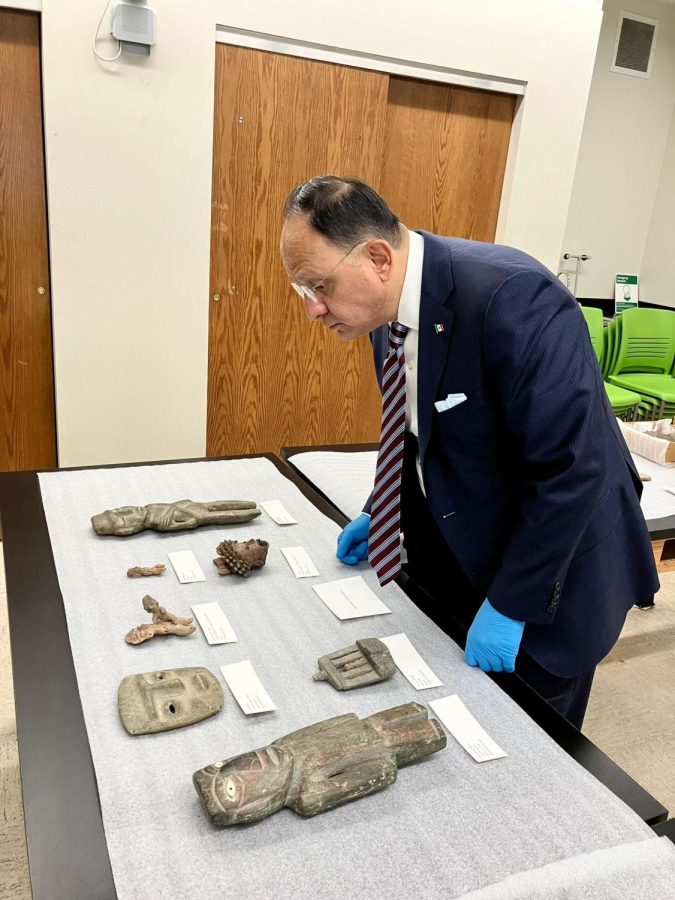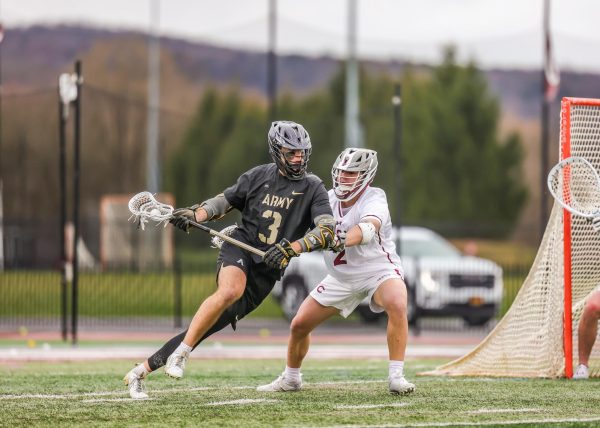Consul General of Mexico Visits Colgate University to Commence Repatriation Initiatives
Jorge Islas López, Consul General of Mexico in New York, accompanied by a Mexican delegation, visited Colgate University last week to launch a strategic cultural partnership between Colgate University and Mexican institutions. The visit was arranged for the signing of a letter of intent between López and University President Brian W. Casey to begin a repatriation initiative to return Mexican cultural artifacts currently held within the University’s various museum collections.
The University undergone an internal evaluation of the provenance of the objects within its collection, according to University President Brian W. Casey. Objects were evaluated by Co-Director of University Museums and Curator of the Longyear Museum of Anthropology Rebecca Mendelsohn along with museum staff, and some were determined to be of funerary use.
The prevalence of funerary objects within the collection launched an initiative to begin exploring reparative efforts to return these objects, and potentially others, in tandem with officials from the office of the Consulate General of Mexico in New York. López was present for the singing of letters of intent that will officially begin this process formally.
“I signed a letter of intent, on behalf of the University, saying that we will begin this conversation. I agree, and the University agrees, that anything that is culturally significant from a religious or religious practice standpoint or is culturally significant to the nation, we agree to return,” Casey said. “This process is only just beginning, and because this is a process crossing international borders, we wanted to clarify this process by inviting the [Consul General of Mexico] to come to observe the objects.”
The letter, signed last week, begins a potentially years-long repatriation process.
“Colgate University agrees to undertake discussion regarding restitution of items of Mexican origin currently held in the University museums of Colgate University,” the letter reads.
During the course of the visit, the Longyear Museum of Anthropology hosted a conversation with López on the role of museums, Mexican cultural heritage and the significance of repatriation on Friday, Mar. 31.
During his opening remarks at the community discussion, Islas expressed his gratitude towards Colgate’s continued collaboration and efforts to return the cultural artifacts to their Mexican origins.
“Your warm welcome and hospitality has already allowed us to forge bonds that we know will continue to be expanded,” Islas said. “You at Colgate University are sending a very strong message to the world’s institutions that ethics, morality and decency are important for new generations, and I congratulate you for that. This institution is an example of [how] things have to be done properly.”
Islas explained that the current Mexican administration considers repatriation to be an essential part of Mexican foreign policy.
“The Mexican government that is headed by President López Obrador is giving an enormous relevance to the recovery of our historical and cultural heritage as a foreign policy,” Islas said. “This policy is based on the understanding that the defense and protection of our heritage is essential for the reconstruction of national pride and the identity of the cultures that make up our sense of nation.”
Islas mentioned the diverse work that his consulate undertakes to advance this goal, from working with the Manhattan District Attorney to identify trafficked Mexican artifacts and seize artifacts from museums to advancing litigation against auction houses that sell these artifacts.
In addition, Islas formally invited Provost and Dean of the Faculty Lesleigh Cushing as well as various Colgate professors and faculty to visit Mexico in August, where he plans to organize an itinerary for the group that involves further work towards successful repatriation as well as the establishment of mutually beneficial connections between Colgate and renowned Mexican academic institutions.
“We will present Colgate University with the most prestigious universities, private and public, in Mexico. In the near future, we envision faculty and scholar exchanges with the aim of eventually expanding the programs to students when Colgate sees fit to it,” Islas said. “You will also have the opportunity to see more of our country and interact with our indigenous communities who are the rightful heirs of this important legacy.”
This visit by Islas to the Colgate campus as well as the trip invitation in August represent the advancement of a long and complex process that began in Oct. 2021 with a series of conversations initiated by the consulate. The University’s enthusiastic response in support of repatriating the Mexican cultural artifacts has so far culminated in the letter of intent signed by Casey and Islas on Thursday, March 30. Rebecca Mendelsohn, curator of the Longyear Museum of Anthropology and the co-director of University Museums, explained the significance of this event.
“That is a formal statement that we plan to work together to come up with a plan. That’s kind of where we are today,” Mendelsohn said. “We know we are committed to do this in some form, but we are not quite sure what it’s going to look like yet.”
Casey echoed Mendohlson’s sentiment, seeing Islas’ visit to the university as a statement of Colgate’s future intentions and accepted responsibilities.
“What this trip mostly is is a signal to the Mexican Consulate General in New York and the Mexican people that we really wish to repatriate objects that really belong with them.”
Despite remaining ambiguities about the particularities of the process, Mendelsohn noted that the agreement marks an important moment in Colgate history, and for a repatriation that is entirely voluntary, the immense scale of the artifacts is unique. The discussions center around over 2,000 artifacts, including ceramic pots, sculptures, and stone tools from various pre-Columbian and indigenous civilizations all over Mexico. These artifacts are tangible pieces of Mexican history and important symbols of Mexican culture.
“The restitution of these items will grant our communities the opportunity to try to rebuild their cultural memory,” Islas explained. “You’re returning more than just artifacts to us, you are returning parts of our history and parts of who we are.”
Casey added that five objects have been identified as part of religious practice that will initiate the repatriation efforts, but that the size and scope of the objects’ return process is difficult to gauge before it officially begins.
“This will be a long process,” Casey said. “The recent repatriation of objects to the Oneida Nation took five years. Eventually, both sides will develop a memorandum of understanding that asks ‘How do we do this?’, ‘Who will pay for this?’, ‘Where will the objects be going?’. These processes are always more complicated than we anticipate.”
Some of the objects slated for review are located in the University’s collections housed on campus in Hamilton, NY, and many are housed in secure artifact storage facilities in Elmira, NY.
Mendelsohn asserted that Colgate’s voluntary repatriation represents a pioneering commitment by to decolonizing institutional museums.
“What a lot of museums have been reluctant to do is to give things back, and I think if we are truly going to decolonize, really thinking about the significance of everything that we have in our collections to their communities of origin needs to be a part of the equation too,” Mendelsohn said.
Kelsey Olney-Wall, NAGPRA assistant at the Longyear Museum specializing in compliance with indigenous repatriation law, explained that Colgate has emerged as an international leader in voluntary repatriation through the ongoing discussions with the Mexican consulate.
“Colgate is relatively a smaller institution compared to these other ones, and I think it is setting a precedent for smaller institutions, that they don’t need to be the [Metropolitan Museum of Art], they don’t need to be these large institutions to know that they can also start working on decolonizing, and breaking those structures down, and doing the right thing, and inviting communities in and having those community members tell them what they want,” Olney-Wall said. “We’re trying to, in our own way, set little pieces in motion to really show others that it is hard, but it’s also possible and it’s important.”
Ultimately, Mendelsohn believes that this repatriation will have only benefits for both parties involved.
“The relationships that we build and we develop, and the artists that we meet, these are all things that come back to benefit the museum, full circle. It’s truly not a loss when you think about it in those terms, that we’re also talking about what we’re going to collect next from Mexico,” Mendelsohn said.
While recognizing that the repatriation process has an unclear timeline, and that decolonization of any kind is necessarily a complex and continuous process, Olney-Wall believes that Colgate students are profoundly committed to working towards these goals.
“You could tell by the great questions that students were asking [during the conversation with Islas] that they’re incredibly bright, incredibly intelligent and very much interested in the way that we are trying to move. During repatriations, I think they’re maybe even a few steps ahead of us,” Olney-Wall said. “I’m very excited for what the next generation of students are going to do because this is going to be probably lifelong, it’s going to be generational.”

Sophie Karbstein is a junior from Jupiter, Fla., concentrating in peace and conflict studies and Russian. She has previously served as Assistant News Editor....








